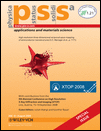Gradual degradation of GaAs-based quantum well lasers, creation of defects, and generation of compressive strain
Abstract
We report on the interplay between compressive strains and defects within the active region of 980 nm emitting high-power diode laser arrays. By analyzing photocurrent data, we show how external mechanical load caused by device packaging results in cumulative defect signatures within their active region. Furthermore, we analyze the reverse situation, where device degradation results in the generation of defect signatures and these defects subsequently act as driving force for the creation of compressive strains within the quantum well active region of the devices. Knowledge about their microscopic nature will be urgently required for creating more robust semiconductor device architectures.




